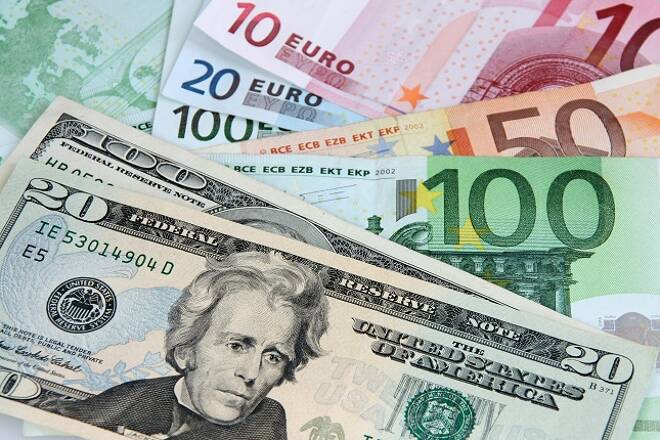Advertisement
Advertisement
EUR/USD Daily Technical Analysis for July 24, 2017
By:
The EUR/USD moved higher on Friday following Thursday’s ECB meeting where forex traders lifted the currency pair to fresh 14-month highs. There appears
The EUR/USD moved higher on Friday following Thursday’s ECB meeting where forex traders lifted the currency pair to fresh 14-month highs. There appears to be a divergence in how the markets viewed the Draghi commentary following the ECB meeting. While forex markets are focusing on upbeat economic comments from Draghi on Thursday and push the EUR higher, bond markets are taking a very different view. Peripheral yields dropped already sharply yesterday and continue to head south today. Bund yields were more volatile, but are also down with Eurozone spreads coming in markedly since the press conference Thursday. Indeed, the ECB may be upbeat on growth, but on inflation, which Draghi made clear is key for ECB policy, the message remains “we are not there yet” even if stronger growth will likely see inflation moving in the right direction going ahead.
Technicals
The EUR/USD broke out hitting fresh 23-month highs and is poised to test the August 2015 highs at 1.1717. The currency markets took the commentary following the ECB meeting as hawkish. The ECB said they would consider how to proceed with quantitative easing once the current program ends in March of 2018. The markets appear to be having a tapper tantrum, which is generating a bid under the currency while yields are moving lower. Stocks are also under pressure. Support on the currency pair is seen near the 10-day moving average at 1.1498. Momentum has turned positive as the MACD (moving average convergence) index recently generated a crossover buy signal. This occurs as the spread (the 12-day exponential moving average minus the 26-day exponential moving average) crosses above the 9-day moving average of the spread. The MACD histogram is printing in the black with an upward sloping trajectory which points to a higher exchange rate.
German-Turkish Tensions Escalate.
The relations between Germany and Turkey have been shaky since Turkey started to arrest German journalists and human rights activists and Erogan tried to take the campaign for his referendum to Germany to address resident Turks. The row escalated yesterday after Turkey blacklisted German companies including Daimler and BASF as supporting terrorism. German foreign minister Gabriel Thursday said the foreign office will be revising its travel advice for Turkey and suggested official Hermes guarantees for trade with Turkey will be reviewed.
German investment in Turkey has already been sluggish amid the escalating row. Turkey’s economy minister today reportedly offered German companies “100% protection” and Turkey reportedly denied the existence of the black list as “fake news”. Still, Deutsche Bank was already accused by Turkish newspapers earlier in the year of attempting “economic terror” and markets are starting to eye the links of Deutsche Bank AG, Volkswagen and others in Turkey. Bloomberg reports that trading ties between the two countries amounted to USD 36 billion last year, with more than 6,800 German firms currently operating in Turkey. The DAX is moving sideways today amid a strong EUR and the tensions with Turkey.
The ECB Survey Shows Inflation Outlook Was Cut
ECB survey shows forecasters cut inflation outlook, up growth forecast. The ECB’s latest survey of professional forecasters showed that inflation forecasts for the period to 2019 have been cut by 0.1% points throughout, but the long-term forecast was still left unchanged at 1.8%. The new projections see inflation at just 1.6% in 2019, still clearly below the ECB’s 2% limit for price stability. At the same time, growth forecasts were lifted to 1.9% this year, 1.8% next and 1.6% in 2019, from 1.7%, 1.6% and 1.5% respectively previously. The longer-term growth forecast was left unchanged at 1.6%. Unemployment forecasts were also cut back, but that doesn’t seem to have impacted inflation expectations.
UK Government Borrowing Was Higher than Expected
UK government borrowing was higher than expected, according to the latest public finances data, for June. The net borrowing figure, ex lending to the financial sector, was GBP 6.3 billion, well up on the median forecast for GBP 4.9 billion, while the May figure was revised up to GBP 6.4 billion from the GBP 6.0 originally reported. The rise is mostly blamed on higher financing costs as a consequence of inflation, which spiked to 2.9% year over year May before settling to 2.6% year over year in June (still well on the 0.5% year over year rate seen in June in the previous year), and its impact on inflation-linked securities.
About the Author
David Beckerauthor
David Becker focuses his attention on various consulting and portfolio management activities at Fortuity LLC, where he currently provides oversight for a multimillion-dollar portfolio consisting of commodities, debt, equities, real estate, and more.
Did you find this article useful?
Latest news and analysis
Advertisement
